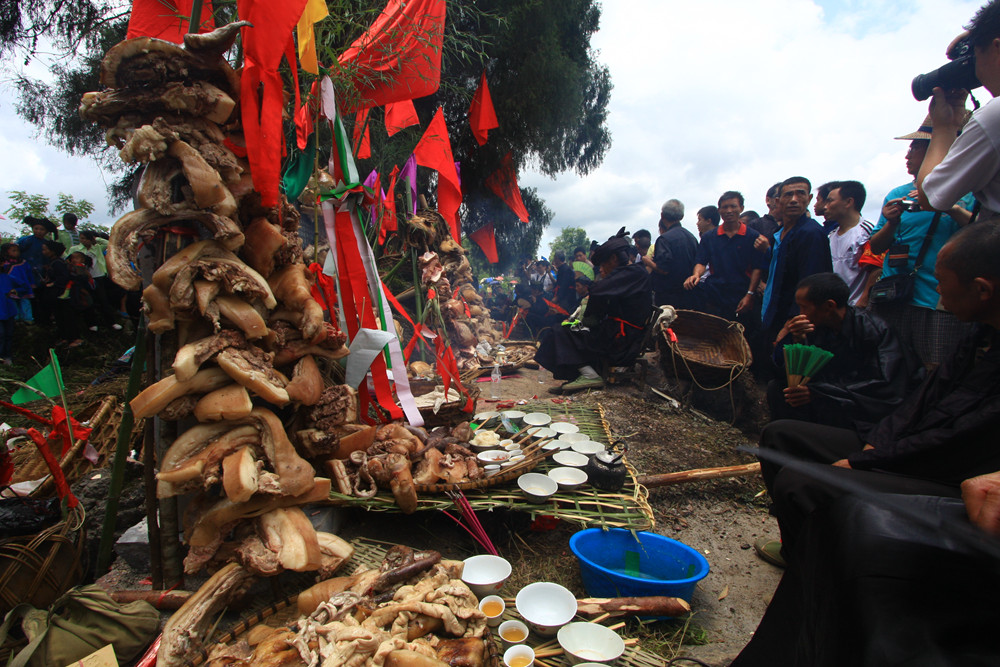- Profile Jurisdictions GOV DEPARTMENTS Cultures Travelling Educate
-
Sandu is the nation's sole Miao Autonomous County, situated in the southeastern part of Qiannan Buyi and Miao Autonomous Prefecture, Guizhou Province. Nestled within the heart of the Moon Mountains and Leigong Mountains, it lies between 107°40′ and 108°14′ east longitude and 25°30′ and 26°10′ north latitude. It borders Rongjiang and Leishan to the east, Libo to the south, Dushan and Duyun to the west, and Danzhai to the north. Spanning 56 kilometers east-west and 78 kilometers north-south, the county covers a total area of 2,400 square kilometers. It administers 6 towns, 2 subdistricts, 87 administrative villages, and 18 community neighborhood committees, with a total population of 400,000. Ethnic minorities constitute 97.4% of the county's population, with the Shui ethnic group accounting for 67%. Over 63% of China's Shui population resides in Sandu, making it the Shui people's stronghold, major settlement area, and economic, social, and cultural center. It has earned titles including “China's Crystal Grape Capital,” “China's Horse Racing Capital,” “China's Folk Culture and Arts Capital,” “National Senior Aerobic Volleyball Capital,” “National Model County for Ethnic Unity and Progress,” and “One of China's Top 100 Counties for Effective Relocation Work.” Sandu became the first county to be listed among “China's Most Beautiful Counties in 2021,” renowned as “a place as beautiful as a phoenix feather.”

Sandu boasts profound Shui cultural heritage. According to scholarly research, the Shui people originated in the Suishui River basin as descendants of the Shang Dynasty, referring to themselves as “Suishui.” They later migrated and integrated into the Baiyue ethnic groups, formally adopting the name “Shui” during the Tang Dynasty and entering the annals of Chinese history. Over centuries, the Shui people developed their own language, script, and calendar, cultivating distinctive customs, beliefs, and festivals. Among these, Shui script, the Shui Dragon Boat Festival, Shui horsetail embroidery, Shui paper-cutting, and the Shui dual-voice singing “Xuzhao” have been inscribed on the National Intangible Cultural Heritage List. Shui horsehair embroidery has earned the title of “National Geographical Indication Protected Product,” while Shui script archives have been successfully included in the UNESCO Memory of the World Register for the Asia-Pacific Region. The Shui script custom is currently being nominated for the UNESCO Representative List of the Intangible Cultural Heritage of Humanity, and a proposal for an international coding system for Shui script is under consideration by the International Organization for Standardization (ISO).
Sandu, where ethnic charm captivates. Home to ethnic groups including the Shui, Buyi, Miao, Dong, and Yao, the region boasts rich and distinctive ethnic traditions. It boasts Shui Script, a living fossil of Chinese pictographic writing; the Shui Horsehair Embroidery, a living fossil of Chinese embroidery art passed down through generations; the Shui Duan Festival, a national intangible cultural heritage; ancient celebrations like the Shui Mao Festival (ancient Oriental Valentine's Day) and the Shui Jingxia Festival; The region showcases the Shui Bronze Drum Dance and Horned Dance, the Miao Reed Pipe Dance and Ancient Gourd Dance, and the Miao ethnic dance “Stomping the Moon,” which won the Silver Lotus Award for Chinese Dance and the Golden Guizhou Award for Colorful Guizhou. Notable tourist villages include Dujiang Zhenlei, Jiuzhan Shuige, Pu'an Gaodong, and Lalan Paishao, alongside historical sites such as the ancient city walls of Dujiang and the Shuiliangyin Lang stone slab tomb clusters.

Sandu boasts an excellent ecological environment. Its pristine landscapes feature clear waters and lush mountains, offering pleasant scenery and a mild climate. With a forest coverage rate of 72.47%, it ranks among Guizhou's ten key forestry counties. The region's air contains 10,000 to 50,000 negative oxygen ions per cubic centimeter, earning it titles like “China's Forest Oxygen Bar” and “China's Ecologically Charming County.” The beautiful Duliujiang River flows through the county, showcasing the Western Region's green gem—Yaoren Mountain National Forest Park, the Hundred-Mile Gallery and provincial scenic spot—Sandu Duliujiang Scenic Area, and Guizhou's Top Ten Charming Tourist Attractions and National 3A-rated tourist site—Gulu Egg-Laying Cliff.
Sandu boasts abundant natural resources. Over 220 rivers (including tributaries) traverse the county, with 43 having basins exceeding 20 square kilometers. The largest river is the Duliujiang, providing an average annual surface water resource volume of 1.68 billion cubic meters and exploitable hydropower capacity of 166,000 kilowatts. Over 20 mineral resources have been identified, including copper, iron, coal, mercury, gold, and antimony. The region is renowned for its agricultural specialties: Jiuchuan liquor, Jiuchuan plums, Sandu crystal grapes, Dujiang pomelos, Wubu Fragrant Pigs, Zhouqin Premium Rice, Dahe Navel Oranges, tea, edible fungi, medicinal herbs, high-quality vegetables, Sandu Chili Peppers, and Sandu Vinegar. These agricultural specialties are exported to the Pearl River Delta, Sichuan, Chongqing, Hunan, and other regions. The county has earned certifications for 3 green foods and 7 organic agricultural products, establishing itself as a vital “fruit basket” and “vegetable basket” for the Pearl River Delta region.
Sandu holds vast development potential. The county hosts six provincial-level agricultural demonstration zones, including the Jiaoli Mountain Ecological Grape Industrial Demonstration Park and the Zhouqin Hong Kong-Guangdong Specialty Vegetable Industrial Park. Tea cultivation spans 108,400 mu (72,267 acres), forming a distinctive mountainous agricultural system centered on tea and vegetables, complemented by fruit, medicinal herbs, edible fungi, and eco-friendly livestock farming. The industrial real economy continues to expand and strengthen. Companies like China Electric Power (Sandu) New Energy Co., Ltd. and Guizhou Qunshan Wood Industry Co., Ltd. consistently drive industrial growth and enhancement. New energy projects, including photovoltaic and wind power, have successively been established in Sandu. Local private enterprises such as Genlan Mutu Ethnic Textile Batik Development Co., Ltd. and Tianfu Steel Structure Co., Ltd. are growing rapidly. Fifty-four villages in the county have been listed as Traditional Villages of China, indicating immense potential for tourism development.

Sandu boasts superior transportation access. The county seat is 68 kilometers from Duyun (prefecture capital), 177 kilometers from Guiyang (provincial capital), and over 600 kilometers from Guangzhou. Major highways including G321, G243, S205, and S517 highways. The Xiamen-Chengdu Expressway, Yu'an Expressway, Sandu-Lichuan Expressway, Lichuan-Rongcheng Expressway, and Guiyang-Guangzhou High-Speed Railway traverse the county east to west, featuring access ramps and high-speed rail stations. High-speed rail travel takes only 12 minutes to Duyun, 50 minutes to Guiyang, and 4.5 hours to Guangzhou. Planned projects like the Yongxing Railway will complete an integrated transportation network encompassing expressways, high-speed rail, conventional rail, and highways. This advanced transportation infrastructure and strategic location provide convenient access for Sandu to integrate into the Qianzhong Economic Zone, the Changzhutan Economic Zone, and the Pearl River Delta Economic Zone. It establishes a modern economic foundation for Sandu to connect with rivers and seas, and reach the world.
contact details
Tel:00-86-0854-3922580
Address:Sandu Shui Autonomous County Administrative Centre Building, 3rd floor.
Working hours:Monday to Friday 8:30 a.m. - 12:00 p.m. 2:30 p.m. - 6:00 p.m. (excluding national holidays)
